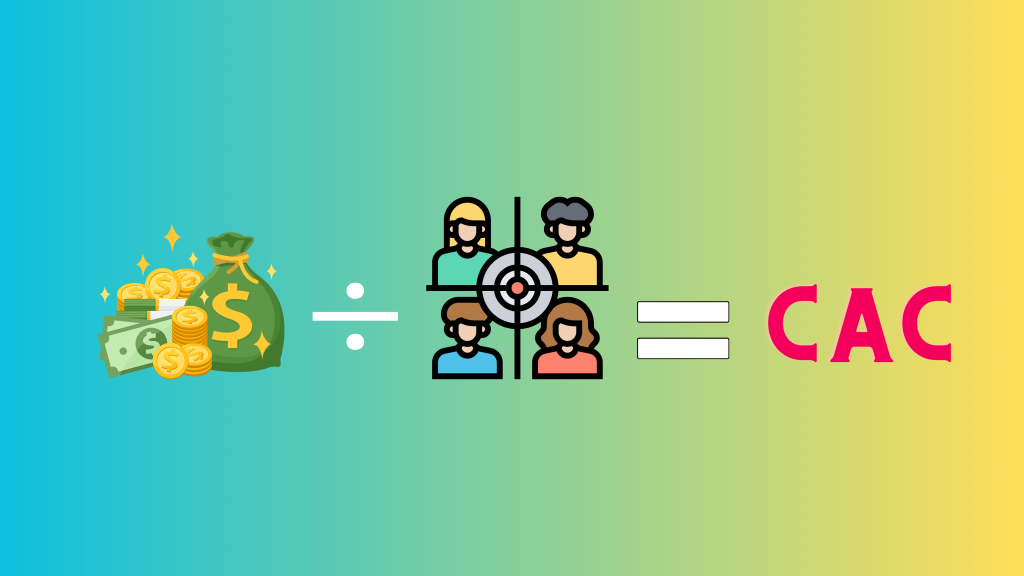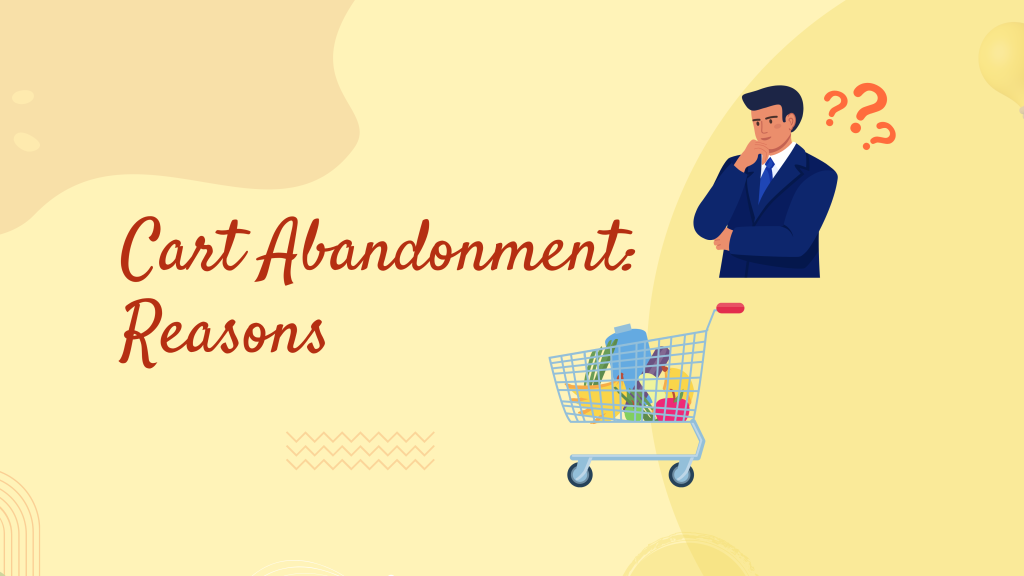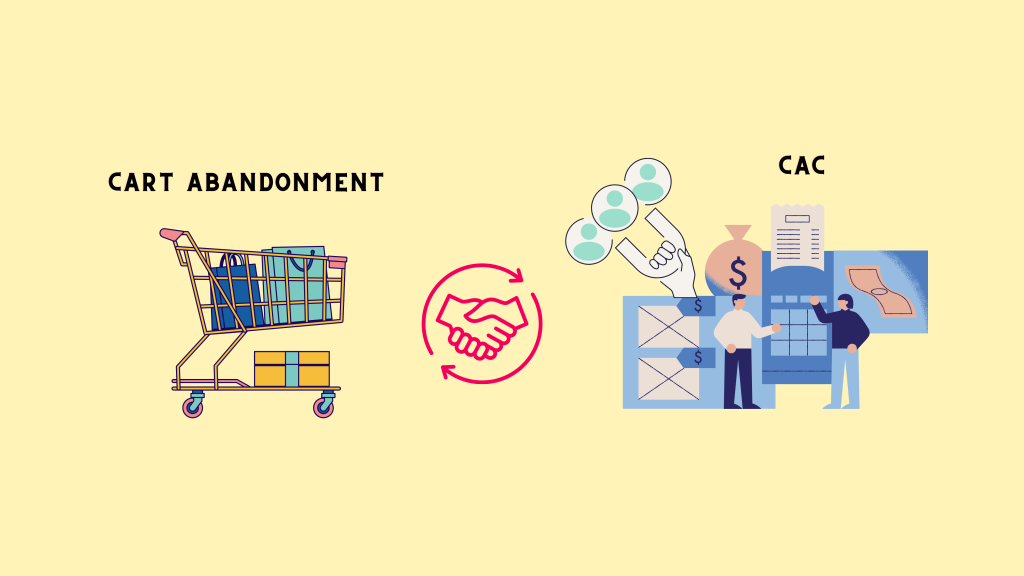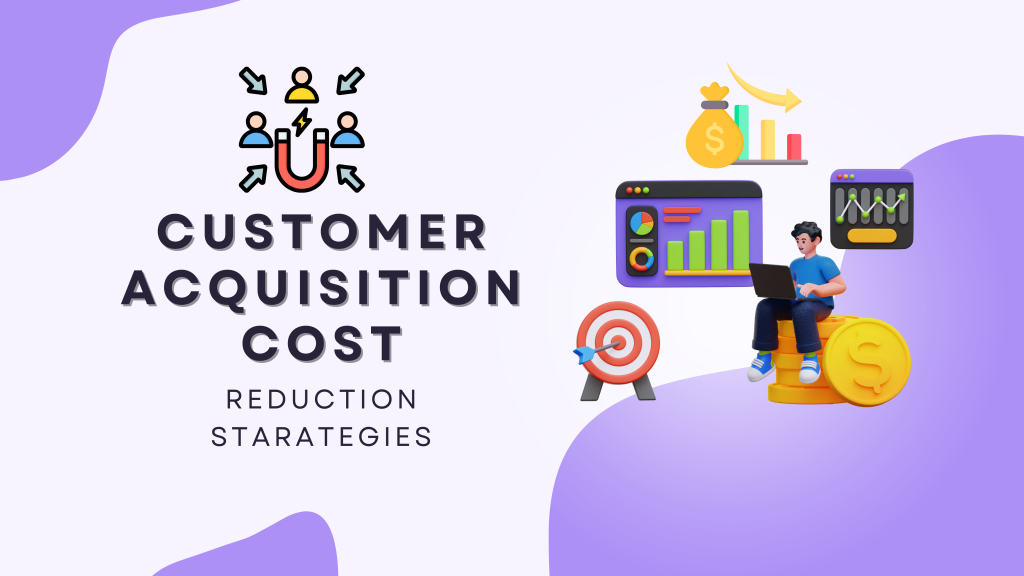Table of Contents
Acquiring customers is a triumph, but do you know the real cost behind each sale?
In the eCommerce world of 2024, understanding and mastering Customer Acquisition Cost (CAC) is at the core of survival. Moreover, there’s also a virtually “secret” or hidden aspect of eCommerce that influences CAC! This points to abandoned carts, a lesser-known factor in connection with CAC with significant implications.
Moving further, in stark reality, data reveals a formidable 60% surge in customer acquisition costs between 2017 and 2022. Notably, eCommerce enterprises grapple with an average loss of $29 for every freshly acquired customer.
As experts dissect such intricacies, one thing becomes evident. Achieving the right CAC to LTV (customer lifetime value) ratio and averting cart abandonment are not just advantageous – but also indispensable for sustainable growth for 2024’s cut-throat eCommerce ecosystem.
That being said, this article delves into the less-explored relationship between abandoned carts and CAC, emphasizing the crystal-clear reality of eCommerce Customer Acquisition Cost and underscoring the strategic importance of customer retention. Read on to find out more and prepare yourself for a year of success ahead!
Source: Average CAC by B2C Industry
Understanding Customer Acquisition Cost (CAC)
First, let’s take a look at the key principles of Customer Acquisition Cost.
Definition and Calculation of CAC
Customer Acquisition Cost is a fundamental metric that encapsulates the total expenses a business incurs in the process of acquiring a new customer. It provides a comprehensive overview of the financial investment required to convert a potential lead into a paying customer.
CAC encompasses a spectrum of costs, ranging from marketing and advertising expenditures to sales team wages, all contributing to the goal of bringing a product or service to the target audience’s attention.

The calculation of CAC involves proper consideration of all relevant expenses incurred during a specific timeframe. Upon isolating these costs and dividing the total by the number of new customers acquired within the same period, businesses arrive at a quantifiable metric that reflects the average cost associated with acquiring each customer. However, this is just the tip of the iceberg when it comes to CAC and its weight.
It is important to understand the following when looking at CAC and its calculation:
Basic Customer Acquisition Cost: CAC represents the total expense incurred by a business to acquire a single customer. It includes marketing costs, advertising, and other relevant expenditures.
- Formula: Total Marketing and Acquisition Spend / New Customers = CAC
- Example: A company spends $1,000 on digital advertising, gaining 20 new customers. In this case, the CAC is $50 ($1,000 / 20).
Cost of Goods Sold (COGS): COGS encompasses the direct expenses linked to the production of goods, covering raw materials, manufacturing labor, and related costs.
- Formula: (Total Marketing Spend + COGS) / New Customers = True CAC
- Example: For a bakery, COGS includes the cost of flour, sugar, and labor directly involved in baking a batch of cookies.
Average Order Value (AOV): AOV denotes the average monetary value of each customer order, calculated by dividing the total revenue by the number of orders.
- Formula: Total Revenue / Number of Orders = AOV
- Example: An eCommerce store with $5,000 in total revenue from 100 orders has an AOV of $50 ($5,000 / 100).
Gross Margin: Gross margin is the profit retained after deducting the direct costs associated with producing goods from the total sales revenue.
- Dollar Formula: Net Revenue – COGS = Gross Margin
- Percentage Formula: (Net Revenue – COGS) / Net Sales x 100 = Gross Margin
- Example: If a product sells for $200, and its production costs (COGS) are $80, the gross margin is $120 ($200 – $80).
Profit: Profit is the financial gain obtained by subtracting the CAC from the product of AOV and gross margin.
- Formula: (AOV x Gross Margin) – CAC = Profit
- Example: With an AOV of $50, a gross margin of $30, and a CAC of $20, the profit is $10 ($50 x $30 – $20).
Break-even Analysis: It identifies the point where total revenue equals total costs, indicating neither profit nor loss.
- Example: A business with fixed costs of $10,000 and a product selling for $100 needs to sell 100 units to break even ($10,000 / $100).
Source: Defining Well-Rounded CAC
Understanding CAC from this well-rounded perspective allows businesses to quantify the financial implications of acquiring customers. It also facilitates informed decision-making by providing a baseline for assessing the cost-effectiveness of their marketing and sales initiatives.
The precision in calculating CAC empowers businesses to allocate resources strategically, optimize campaigns, and refine their customer acquisition strategies for enhanced overall efficiency and profitability.
Impact of Customer Lifetime Value (LTV) on CAC
Customer lifetime value (LTV) holds significant importance in gauging overall profitability as it assesses the potential revenue generated from a customer throughout the entire relationship.
The interconnection between Customer Acquisition Cost (CAC) and customer lifetime value is expressed through the LTV:CAC ratio, an important metric in evaluating business profitability. This ratio verifies whether the customer’s value surpasses, falls below, or equals the cost incurred in acquiring them.
A healthy LTV:CAC ratio for eCommerce businesses is 3:1
A ratio lower than this poses a risk to the business, signaling potential financial challenges. Conversely, a higher ratio indicates readiness for scaling operations. This calculation proves instrumental during strategic overhauls, guiding decisions in both business and marketing strategies for optimal outcomes.
Importance of Monitoring eCommerce Customer Acquisition Cost for Business Growth
Monitoring CAC is a strategic call for businesses looking to achieve sustainable growth. It provides a tangible framework for assessing the financial health of customer acquisition efforts, optimizing marketing strategies, and fostering an environment where businesses can adapt and thrive in the competitive landscape.
Profitability Benchmark
Monitoring Customer Acquisition Cost (CAC) is paramount for businesses aiming for sustained growth and long-term profitability. CAC serves as a critical benchmark that directly influences the viability of a business model.
It sheds light on the delicate balance between the costs incurred to acquire customers and the revenue generated from those customers. Essentially, CAC determines the minimum amount of revenue a business needs to earn from each customer to remain profitable.
Regularly tracking CAC can help businesses gain insights into the health of their customer acquisition efforts. If the cost of acquiring customers exceeds the revenue they generate, it raises a red flag about the sustainability of the business model. This insight is foundational for making strategic decisions about pricing, marketing expenditures, and overall financial planning.
Efficiency in Marketing Channels
One of the key advantages of monitoring CAC lies in its ability to assess the efficiency of different marketing channels. After analyzing CAC data, businesses can discern which marketing channels and campaigns are delivering the most value. This data-driven approach allows for the optimization of marketing budgets by reallocating resources to the most effective channels, ensuring maximum return on investment (ROI).
For example, if social media advertising consistently yields a lower CAC compared to traditional print advertising, a business can reallocate funds to social media campaigns to enhance overall efficiency. Such forward-thinking helps marketing strategies remain adaptive and aligned with the constantly changing fundamentals of consumer behavior.
Sales Funnel Optimization
Understanding CAC is not just about the numbers; it’s about identifying inefficiencies within the sales funnel. Analyzing CAC provides a detailed view of the customer journey, pinpointing areas where excessive spending might be hindering the smooth progression of customers through the funnel. This insight is invaluable for streamlining the customer experience, identifying potential roadblocks, and reducing friction points that may impede conversions.
For instance, if a significant portion of the budget is allocated to a stage in the funnel with a high dropout rate, businesses can reassess and optimize that specific stage to improve conversion rates. This approach makes sure that marketing resources are utilized effectively, leading to a more efficient and cost-effective customer acquisition process.
Reference to Industry Benchmarks
Referencing industry benchmarks has multifaceted benefits. It helps align with industry averages and is also a strategic tool for businesses aiming to optimize their customer acquisition efforts.
Understanding such variation across industries and utilizing benchmarks for decision-making can help businesses fine-tune their strategies. Let’s examine the concept of industry benchmarks with respect to CAC further.
Benchmark Significance
Industry benchmarks serve as essential reference points for businesses seeking to evaluate the competitiveness of their Customer Acquisition Cost. These benchmarks offer a comparative analysis, illustrating how a company’s CAC aligns with the standards prevalent in its respective industry.
Understanding and referencing industry averages provide context to a business’s performance and aids in setting realistic goals for customer acquisition efficiency.
Variation Across Industries
Average customer acquisition cost for eCommerce sector is $70
The average CAC varies significantly across diverse industries, reflecting the distinct challenges and dynamics each sector faces. For instance, in the Software as a Service (SaaS) industry, the average CAC is reported to be $702, indicating the specific cost structure and customer acquisition challenges within this sector. On the other hand, B2B companies, with their unique blend of organic and paid acquisition, maintain an average CAC of $536.
Source: Average CAC by B2B Industry
In terms of eCommerce Customer Acquisition Cost, where the diversity of industries is pronounced, the average CAC ranges widely, with an overall average of $70.
Source: Average eCommerce CAC
Benchmark Utilization
Referencing industry benchmarks provides businesses with a critical yardstick for evaluating the efficiency of their customer acquisition strategies. A CAC significantly higher than the industry average prompts businesses to scrutinize and optimize their processes.
Conversely, a CAC lower than the industry norm may indicate a competitive advantage but warrants a careful examination to ensure that it doesn’t compromise other aspects of the business.
For instance, if a business in the eCommerce sector observes a CAC considerably higher than the industry average, it may trigger a reassessment of its marketing channels or a deeper dive into customer segmentation strategies.
This strategic utilization of benchmarks enables businesses to stay agile and responsive to industry trends, ensuring that their customer acquisition efforts remain effective and competitive.
Strategic Decision-Making
Informed decision-making relies on a contextual understanding of a business’s position in relation to industry standards. Utilizing benchmarks enables businesses to make strategic decisions about their customer acquisition appeal.
If the CAC surpasses the industry average, it prompts a closer look at marketing channels, messaging, or targeting strategies. On the other hand, if the CAC is lower than average, businesses might explore opportunities for scaling or expanding their customer base.
Competitive Edge
Maintaining awareness of industry benchmarks not only allows businesses to adapt their strategies but also positions them competitively. It helps set realistic goals, gauge performance, and identify improvement areas.
Moreover, businesses can use benchmarking as a tool for continuous improvement, striving not just to meet industry standards but to surpass them.
The Pain Point: Cart Abandonment
Cart abandonment is a prevalent eCommerce phenomenon characterized by users adding products to their virtual shopping carts but leaving the website without completing the purchase. This behaviour represents a crucial challenge for online retailers, as it signifies a missed opportunity to convert potential customers into actual buyers.

Despite the user’s initial interest and intent to purchase, various factors contribute to the abandonment of the shopping cart during the checkout process.
Reasons for Cart Abandonment
- Unexpected Costs: One of the leading causes is the revelation of unexpected costs during the checkout process. Additional fees, such as shipping costs or taxes that were not transparent earlier in the user journey, can lead to a change of mind.
- High Free Shipping Threshold: A high minimum purchase threshold in order for customers to qualify for free shipping is also a reason for cart abandonment.
- Complicated Checkout Process: A lengthy or complicated checkout process is a significant deterrent. Users seek a seamless and straightforward experience, and any complexities in the final steps may result in frustration and abandonment.
- Security Concerns: Concerns about the security of personal and financial information can prompt users to abandon their carts. Trust is crucial in online transactions, and any doubts about the safety of their data may lead to hesitancy.
- Lack of Payment Options: Limited payment options or the absence of the user’s preferred payment method can hinder the completion of the purchase. Offering a variety of payment options caters to diverse user preferences.
- Comparison Shopping: Users often use the shopping cart as a tool for comparison shopping. They may add items to the cart on one platform while exploring alternatives on other sites, leading to abandonment on certain platforms.
- Distractions and Interruptions: External factors, such as unexpected interruptions or distractions during the checkout process, can divert users’ attention away from completing the transaction. This may include pop-up notifications, phone calls, or other disruptions.
Understanding these causes is essential for businesses to devise effective strategies to reduce cart abandonment and enhance the overall conversion rate. It involves optimizing the checkout process, addressing cost concerns, and providing a secure and user-friendly environment that encourages users to complete their purchases.
Through the identification and mitigation of these factors, businesses can minimize cart abandonment. They can then maximize their chances of converting potential customers into ones that return time and again.
We have already covered in detail the reasons for online shopping cart abandonment and how to reduce it.
Refined CAC Formula for Deeper Insight on CAC & Cart Abandonment
Cart abandonment poses a direct challenge to Customer Acquisition Costs by undermining the efficiency of marketing efforts. CAC is a critical metric that quantifies the resources invested in acquiring a new customer.
Businesses deploy various marketing channels, campaigns, and strategies to attract users to their websites with the ultimate goal of converting them into paying customers. However, when users abandon their shopping carts, the initial investment made in acquiring them does not translate into completed transactions, thereby increasing the effective CAC.
The refined CAC formula by incorporating the Cart Abandonment is-
| Adjusted Customer Acquisition Cost = Initial CAC / 1- CartAbandonment Rate |
Let’s assume that the initial CAC is $20 for an eCommerce store. According to studies, the average cart abandonment rate is around 70%. Let’s be optimistic and consider the store has a 30% cart abandonment rate.
30% cart abandonment means you are converting 70% of the audience. Now, the adjusted CAC will be –
| Adjusted CAC = $20 / (1 – 0.3) Adjusted CAC = $20 / (0.7) Adjusted CAC will be approximately $28.57 |
I.e., the customer acquisition cost is $8.57 higher than the initial customer acquisition cost.
The Relationship Between Cart Abandonment and CAC

Here’s how cart abandonment poses a significant challenge in terms of high Customer Acquisition Cost (CAC) due to the direct impact on the efficiency and cost-effectiveness of the acquisition process.
- CAC Optimization Hindered: Incomplete transactions resulting from cart abandonment hinder the optimization of marketing channels. Businesses rely on data from completed transactions to assess the efficiency of specific channels or campaigns. When users abandon their carts, this valuable data becomes limited, making it challenging to allocate marketing resources effectively. The lack of insight into which channels are performing optimally impedes businesses from refining and optimizing their customer acquisition strategies.
- Wasted Acquisition Spend: The resources allocated to attract visitors and convert them into customers are essentially wasted when a potential buyer abandons their cart. Advertisements, marketing efforts, and other acquisition expenses contribute to the CAC, and if the customer does not complete the purchase, these investments yield little or no return.
- Increased CAC Per Conversion: When a transaction fails to materialize due to cart abandonment, the CAC per successful conversion increases. The cost is distributed among fewer completed transactions, amplifying the financial burden on each successful acquisition.
- Inefficient Resource Allocation: High cart abandonment rates indicate that efforts may not be effectively targeted or that the user experience is lacking. This inefficiency results in a misallocation of resources, contributing to the overall increase in CAC.
- Reduced Return on Ad Spend (ROAS): Uncompleted transactions diminish the return on investment from advertising spend. Ad campaigns that bring visitors to the site lose their effectiveness if those visitors do not convert into customers.
- Undermines CAC to LTV Ratio: A successful e-commerce strategy aims for a healthy Customer Acquisition Cost to Lifetime Value ratio (i.e., 3:1). Cart abandonment disrupts this equilibrium, as the investment in acquiring customers may not be justified by their subsequent lifetime value.
- Compromised Profit Margins: Higher CAC resulting from cart abandonment can erode profit margins. The cost of acquiring customers who don’t complete purchases negatively impacts the overall financial health of an e-commerce business.
The linkage between cart abandonment and eCommerce Customer Acquisition Cost challenges emphasizes the need for businesses to recognize the interconnectedness of these two crucial aspects of the customer acquisition process.
Strategies aimed at reducing cart abandonment directly contribute to the optimization of CAC. This involves not only addressing the specific causes of cart abandonment but also implementing strategic measures to encourage users to complete their transactions.
An Example to Understand the Linkage…
For instance, if an eCommerce business invests heavily in social media advertising. Say $20 to acquire new customers.
If a significant number of users initiate the checkout process by clicking on a social media ad but abandon their carts before completing the purchase, the CAC for those users increases.
” Cart abandonment directly impacts the efficiency of the investment. “
This means that the marketing budget allocated to social media advertising did not result in actual conversions, impacting the overall return on investment (ROI) and CAC for that specific channel.
Looking at Greater Awareness
Many businesses remain oblivious to cart abandonment’s profound impact on their Customer Acquisition Cost. The prevailing lack of awareness is a critical blind spot that hampers strategic decision-making in the fiercely competitive e-commerce landscape.
A considerable number of entrepreneurs and marketers underestimate the direct correlation between the rate of abandoned carts and the financial ramifications for CAC. The true cost of acquiring a customer is often obscured by a focus on attracting visitors, leading to an incomplete understanding of the conversion funnel.
Consequently, the disconnect between customer acquisition efforts and the tangible outcomes of completed transactions remains overlooked. It is imperative for businesses to recognize that addressing cart abandonment is not merely a concern for the conversion rate but a pivotal factor in optimizing CAC efficiency and achieving sustainable growth.
Awareness of this often underestimated relationship is a critical step towards refining acquisition strategies and fortifying the financial health of eCommerce enterprises in the upcoming years.
Combined Threat of Acquisition Expense and Conversion Leaks
High Customer Acquisition Costs pose a substantial burden on overall business expenses. As the cost of acquiring each customer increases, it directly impacts profitability. Excessive spending on marketing, sales efforts, and advertising without commensurate returns strains financial resources. This hampers short-term financial health and also impedes long-term sustainability.
Ineffective strategies that result in a high CAC can lead to diminished profit margins, hindering a business’s ability to invest in growth, innovation, and customer-centric initiatives.
Frequent cart abandonment introduces operational inefficiencies and revenue loss. It reflects a breakdown in the customer journey, indicating that potential buyers are opting out at a critical stage. Beyond the immediate loss of sales, it creates a ripple effect by increasing acquisition costs to re-engage those lost customers.
Additionally, it erodes customer trust and satisfaction, impacting brand reputation. Businesses grapple with the challenge of optimizing the conversion funnel to mitigate cart abandonment, emphasizing the need for strategic interventions.
The combined impact of high CAC and frequent cart abandonment imposes a significant financial burden on businesses. The resources invested in acquiring customers may not yield the expected returns if a considerable percentage abandons their carts. This double-edged challenge results in a strained budget, limiting opportunities for growth and innovation.
The financial burden extends beyond immediate revenue loss, affecting the overall health and competitiveness of the business in the dynamic eCommerce landscape. Addressing these issues becomes imperative for businesses aiming to enhance financial resilience and long-term viability.

Wondering how to bring back your Abandoned cart users?
Abandoned Cart Pro for WooCommerce is loaded with useful features that help you send an effective volume of reminders via text, email, and messenger. You can also share and manage discount codes that will encourage your customers to complete their orders.
Even better, you can stop the cart abandonment with the exit intent popup!
Abandoned Cart Pro for WooCommerce is a practical tool to address the cart abandonment issue and help you reduce customer acquisition costs. Abandoned Cart Pro lets you re-engage with your customers by capturing their email addresses. You can send reminders about the abandoned cart details via email, SMS, and FB Messenger.
To improve the chances of conversions, you can create discount coupons within the Abandoned Cart Pro plugin itself and track the performance & claim rates of the coupons. You can also use exit intent popups to proactively stop the users from closing the tabs.
Abandoned Cart Pro for WooCommerce directly helps you to reduce customer acquisition costs and have more profitable sales.
Strategies to Reduce Customer Acquisition Cost in 2024

Remember, data and stats are your best friends!
In the journey to reduce Customer Acquisition Cost (CAC), a data-driven approach is important. Businesses must carefully analyze data and statistics from diverse sources to gain a comprehensive understanding of their industry, competitor movements, and customer behaviors. This involves tapping into market research reports, industry benchmarks, and reliable analytics tools.
Analyzing industry benchmarks provides businesses with a yardstick to measure the effectiveness of their CAC against competitors. It enables them to identify areas of improvement and set realistic targets aligned with industry standards. Moreover, delving into competitor strategies unveils valuable insights that can inspire innovative approaches to customer acquisition.
Customer behavior data is equally crucial. Studying metrics such as conversion rates, click-through rates, and customer journey analytics helps businesses discern the most effective marketing channels. This data-driven decision-making ensures that resources are strategically allocated to channels that yield the best return on investment, ultimately reducing CAC.
Tips on Lowering Average CAC
Effectively reducing Customer Acquisition Costs (CAC) demands strategic restructuring. Here are practical and diverse ways to optimize and diminish your CAC:
- Embrace Organic Marketing
Organic marketing channels, including email campaigns, Search Engine Optimization (SEO), and referral programs, offer cost-effective avenues to drive website traffic and customer engagement. By prioritizing these methods, businesses can establish a sustainable and efficient means of customer acquisition without incurring high costs associated with paid advertising.
- Evaluate and Enhance Marketing Channels
Analyzing the performance of various marketing channels is crucial for optimizing your budget. Identify channels with the best return on investment (ROI) and strategically allocate resources to maximize their impact. Regular assessments allow businesses to adapt their strategies, ensuring a focused and efficient use of marketing budgets.
- Refine Conversion Funnels
Optimizing conversion funnels involves scrutinizing each stage of the customer journey, from initial interaction to final conversion. Identify and eliminate friction points that may hinder the smooth progression of potential customers. A streamlined and frictionless conversion process contributes to increased conversion rates and, subsequently, a reduction in customer acquisition costs.
- Maximize Average Order Value (AOV)
Increasing AOV offsets the impact of a higher eCommerce Customer Acquisition Cost. Businesses can implement tactics such as offering bundled products, upselling complementary items, or providing incentives for reaching a minimum order value. These strategies not only enhance revenue per transaction but also contribute to improved profitability.
- Leverage Customer Segmentation
Utilize data-driven insights to segment your customer base effectively. Identifying distinct customer profiles can help businesses tailor marketing efforts to address specific needs and preferences. Targeted campaigns resonate more with customers, improving conversion rates and ensuring that marketing resources are efficiently directed toward the most receptive audience segments.
- Optimize Cost of Goods Sold (COGS)
Lowering the cost of goods sold involves a comprehensive evaluation of production expenses. Businesses can negotiate with suppliers, explore cost-effective raw materials, and streamline manufacturing processes to reduce overall production costs. Efficiently managing COGS, organizations enhance their profit margins, enabling a more sustainable and cost-effective approach to customer acquisition.
- Implement a Product-Led Growth Strategy
A product-led growth strategy emphasizes allowing users to experience the product before purchase, reducing the need for extensive marketing efforts. Encouraging self-service exploration, providing free trials, and emphasizing the product’s value can enhance customer retention and significantly impact customer lifetime value. This lowers acquisition costs and fosters long-term customer relationships.
- Personalize Onboarding Experiences
Offering personalized onboarding experiences contributes to a positive customer journey. Curation of the onboarding process to individual preferences and needs aids businesses to increase the likelihood of customer satisfaction and engagement. A smooth onboarding experience reduces the need for additional acquisition efforts, as customers are more inclined to convert and remain loyal.
- Implement Referral Programs
Referral programs leverage existing customers as advocates, incentivizing them to refer new users. Word-of-mouth marketing from satisfied customers carries credibility and trust, leading to a higher conversion rate. Upon implementing referral programs, businesses tap into their customer base as a valuable source of leads, effectively lowering acquisition costs while fostering customer loyalty.
- Consider Turning towards Artificial Intelligence (AI)
Leveraging AI technologies, such as chatbots, automated email campaigns, and smart recommendation tools, streamlines marketing efforts. Automation reduces human intervention, allowing businesses to deliver personalized experiences at scale. AI-driven tools can analyze customer behaviour, optimize messaging, and enhance overall marketing efficiency, contributing to a more cost-effective customer acquisition process.
11 Parts of Cost-Effective Customer Acquisition
Ensuring that the above tips bring results and make customer acquisition cost-effective involves a strategic and systematic methodology. Here’s how you can track and achieve long-term success:
- Regularly monitor and analyze data from various sources.
- Implement cart abandonment tracking and recovery system
- Implement continuous optimization based on insights gained.
- Conduct A/B testing for different marketing approaches.
- Collect customer feedback through surveys and direct interactions.
- Monitor industry benchmarks for customer acquisition costs.
- Implement robust ROI tracking for each marketing channel.
- Regularly refine customer segmentation based on updated data.
- Provide training and skill development for the marketing team.
- Make use of advanced technologies, including AI and automation.
- Establish a feedback loop for continuous improvement and iteration.
Case Studies: Businesses with Strategies for Reducing CAC and Boosting CLV
These case studies exemplify diverse strategies businesses have employed to reduce CAC as well as optimize CLV:CAC ratios, showcasing the adaptability and effectiveness of different approaches in various industries.
Fresh: Leveraging Recurring Business Model
- Approach: Fresh, a beauty and skincare brand, implemented an auto-replenish option, offering customers a 10% discount on replenishment orders. This subscription model led to consistent revenue, spreading CAC across multiple transactions and enhancing CLV:CAC ratio.
- Outcome: Increased customer retention, higher CLV, and a sustainable revenue stream.
Savage X Fenty: Maximizing VIP Memberships
- Approach: Savage X Fenty, Rihanna’s lingerie brand, introduced a VIP membership with exclusive benefits like discounts, early access, and free returns. This subscription-based loyalty program boosted CLV by providing added value to members.
- Outcome: Enhanced customer loyalty, increased CLV:CAC ratio, and improved overall profitability.
OneCard: Utilizing On-Ramp Product
- Approach: OneCard, a credit card company, acquired users through a free credit scoring app, OneScore. This on-ramp product efficiently lowered CAC, providing valuable insights for targeting credit card users.
- Outcome: Lowered acquisition costs, efficient user acquisition, and a competitive advantage in the credit card industry.
AirBlack: Community-Driven Sales in EdTech
- Approach: AirBlack, a vocational learning startup, utilized community engagement to drive sales, resulting in a gradual reduction in eCommerce Customer Acquisition Costs over time. This unique methodology in EdTech contributed to sustained customer acquisition.
- Outcome: Lowered CAC, increased brand loyalty, and successful community-driven sales.
Conclusion: Navigating eCommerce Customer Acquisition Cost and Cart Abandonment
In summary, understanding and managing Customer Acquisition Costs (CAC) and addressing cart abandonment with the help of plugins like Abandoned Cart Pro is critical for business success. Looking ahead to 2024, businesses need to adapt to emerging trends, meet evolving consumer expectations, and align strategies for competitiveness.
Anticipated eCommerce Customer Acquisition Trends: 2024
- Virtual Selling: Utilizing online platforms for product presentations.
- Account-Based Marketing: Precision-targeting high-value accounts.
- Social Selling: Engaging customers directly through social media.
- Automation and AI: Streamlining processes and enhancing customer interactions.
As consumer behavior evolves, businesses must grasp and meet changing expectations, ensuring seamless experiences to combat cart abandonment effectively.
In a competitive world, success lies in strategic alignment. Businesses embracing innovation, data-driven decisions, and customer-centric approaches will lead in customer acquisition, ensuring long-term success. eCommerce success demands adaptability, foresight, and a commitment to meet evolving customer needs. Good luck!



